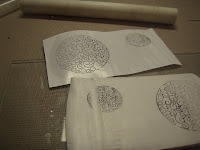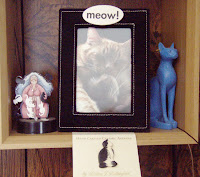I want to address why I would want to do this in the first place when there are so many ready-made texture sheets and rubber stamps available. Well, for several reasons: First, if I want a piece to be truly original, using a commercially made and readily available texture sheet isn’t the way to go. Anyone can purchase them, which means my piece won’t be unique. Second, I will have a piece I can say is truly mine, right down to the texture, which I will draw myself. Third, I won’t have to deal with copyright issues if I use my own texture. This can be an issue for an artist if he or she plans to sell the piece.
And so, after searching the internet, I found several sources for instructions on this technique. I will be using this article by Celie Fago: Hinged Metal Clay Box Pendant, which first appeared in Lapidary Journal Jewelry Artist Magazine in 2006 and is available for download at the link above. If you are at all interested in this technique, download this article, as Ms. Fago has a lot of good background information that I won’t go into here.
Basically, this will be a test to see if the supplies and tools I have will work with this technique. It requires photocopies or prints made from an older photocopier that has iron-based toner (I have also read carbon-based toner). I do have both a toner-based photocopier and printer, but neither is that old so I don’t know how well this will work. The first step is to get my artwork onto my paper (which should be a glossy 32 lb paper – Hammermill or Staples is recommended – and I just so happen to have some of that on hand (yay!)). After fighting with my scanner for a while, I did manage to get my doodle scanned in so I could clean it up. The instructions say it has to be black and white only – no grayscale, so I have to work to get it clean enough to use.
The next step is to get my clay ready. It calls for white (or very light) Sculpey III. I don’t have that. I have white Premo (made by Sculpey) and a pearl Sculpey III (also white Sculpey Ultra Light, but that is such a different texture, I’m not going to try it), so I think I will try both. I’ve run the Premo through the pasta machine at the highest setting and now it’s time to burnish. Putting the image face down on the clay, I rub with my hand in a circular motion for a couple of minutes.

Now I’m and letting it rest under a light for 10 to 15 minutes. Then I burnish and rest it again. After resting, it’s time for the reveal by grasping the edge of the paper and pulling quickly like you would a Band-Aid. And so here are the results of my tests:
The second attempt was just something to do when I was waiting for the first attempt to rest. It was with an image from my HP Printer and using Sculpey Ultra Light. I didn’t expect it to work, and it didn’t. The clay just wasn’t right.
Next I tried some plain vanilla Sculpey III (by that I mean with no sparklies like the pearl has – and the color is vanilla) that I found with another image from my Sharp copier. This one definitely worked the best. The image was thicker and pretty sharp.

The last one is a total experiment. I had read, as I mentioned before, that carbon based toner works best so I wondered what would happen if I drew with charcoal (which is carbon based, right?) onto the paper and used that image. This one was a bust. I am guessing it’s because the charcoal drawing was just too light.
Bottom line: my experiments didn’t work very well. What worked best was the darkest image with the most black using my older Sharp toner-based photocopier printer on the plain vanilla Sculpey III. Basically, follow the directions in the article (and don’t experiment like I sometimes do) and it will work. It might work better if I had access to an older copier. I could tell which was going to work the best after the first resting stage because I could already see the clay attaching itself to the toner through the paper. I'm pretty pleased with the final results. The texture is quite shallow but still visible. The texture sheets give the depressions (the parts that are raised on the texture sheet itself) a rough, matte look.















